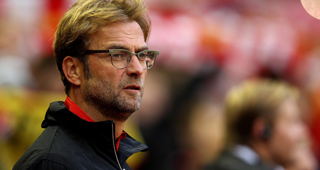Liverpool’s Europa League matchup against Borussia Dortmund was, as Jurgen Klopp said, a story only football could write. The first leg match away at Signal Iduna Park represented his chance to erase the final images of a beloved yet befuddled manager who ran out of ideas just one season prior. This time around, Klopp’s Liverpool pressed, ran, and scored a crucial away goal. Symbolically, there was no time for nostalgia; he was firmly in control as Liverpool’s manager.
The manner of the draw was significant as 20-year-old Divock Origi started in front of Daniel Sturridge and scored Liverpool’s goal. Origi, signed under Brendan Rodgers two summers ago, was loaned out last season and benched at the start of the year. And although Firmino’s role as a lone striker has been the biggest reason for the club’s recent success, Origi’s development may be the defining feature of Klopp’s era.
It was that belief in youth and energy that made Klopp’s approach at Dortmund so exciting. His confidence in Origi has paid off in tangible terms, including this shot-cross that resulted in a goal against Stoke City. Origi said Klopp’s instructions against Dortmund were to “play his game”, and that he hopes to repay his manager’s confidence with more goals. While four goals in three matches is a welcome return for a striker at any age, Origi’s success reveals the importance of relationships of all sorts (Klopp is always quick to mention the Anfield atmosphere being the difference between winning and losing, and one of his early goals was to establish the relationship between players and supporters).
Liverpool have won six out of their last seven league matches, but success wasn’t easy. There were early questions comparing his results to Brendan Rodgers, with Rodgers earning 1.5 points per game this season compared to Klopp at 1.46 points per game. Liverpool had had slightly more possession under Klopp but Liverpool’s weakness under both managers is developing a consistent back four. Center back Martin Skrtel was recently benched in favor of a Dejan Lovren and Mamadou Sakho pairing. Of course, Liverpool worked hard, as one would expect from a Klopp side. But even that simple detail backfired, leading to a series of muscle injuries and inquisitive analysis from Sam Allardyce.
Klopp’s debut match in the Premier League took place against Tottenham and counter pressing brother in arms Mauricio Pochettino (if Klopp is the Socrates of gegenpressing, then Pochettino would be Plato). The October match featured plenty of heavy metal but no goals, which foreshadowed the following months at Liverpool. Tactical analysis largely focused on defense and transitions. After experimenting with formations ranging from a 4-3-2-1 to 4-4-2, Klopp settled on a 4-2-3-1 featuring his signature characteristics of spatial pressing to create turnovers, especially immediately after turning the ball over themselves.
The main criticism against Klopp’s tactics - a lack of creativity against sides who sat deeper - continued to affect Liverpool. The lack of goals put the focus on Christian Benteke’s inability to lead a line under either Rodgers or Klopp (it was the second straight season with a high priced forward flop after Balotelli). At one point, Liverpool’s attack converted only 10% of their shots on goal, 18th in the league. Main playmaker Coutinho was second in England in most missed targets. Adam Lallana and Jordan Ibe were 10th and 11th on the team in chances created.
But the side improved since the season’s low point, a 2-0 loss at West Ham, at the start of 2016. The recent improvement was especially clear the second time Liverpool played Tottenham. Liverpool’s lineup featured two important changes from their first meeting, with Daniel Sturridge’s mobility leading the attack, and Dejan Lovren refinding his Southampton form and anchoring the backline. The two sides drew 1-1.
The two sides were again defined by their counter pressing and energy, but Liverpool’s press was much sharper and focused on keeping Tottenham out of the middle when in possession. Coutinho and Adam Lallana’s ability to close down Deli Alli resulted in the Tottenham midfielder’s most ineffective performance of the season. On top of that, Coutinho’s goal came not in transition but while Tottenham were organized in defense.
Taking their recent run one step further, there are foundational players for Klopp to build around next season. There are rumors of Marco Reus heading to Anfield, but regardless, their creativity goes as far as Coutinho goes. Klopp mixed and matched the midfield behind the Brazilian, focusing on strength and fitness with James Milner, Emre Can and Jordan Henderson (Can’s energy and box to box ability is the framework for future Liverpool midfielders). The mobility of Sturridge, Origi and Firmino sets the tone for both Klopp’s counter press and running channels on counter attacks. For this, former Bayern Munich trainer Andreas Kornmayer was hired to replicate the fitness of German side’s 2014 treble winning season.
But this season was always for editing the roster, with results and memories a byproduct of the first step of a larger process. Instead, Klopp gave Anfield supporters a four goal, second half comeback to beat Dortmund in a match that would be a source of inspiration for decades to come. German newspapers blamed supernatural powers for Dortmund’s defeat. With a young squad, the atmosphere of the stadium, and an inexplicable magic behind them, Liverpool enter their most important phase under Klopp next season: learning how to win.



